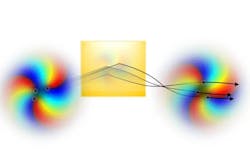Tampere University’s Experimental Quantum Optics Group explores the properties of light waves such as subtle differences of their shape, a.k.a. structured light, and they recently demonstrated the shape of a light beam is slightly distorted when reflected from a flat object such as a mirror.
This topological aberration effect contains information about an object (such as the material it’s made of) and, while theoretically predicted back in 2012, the group’s work marks the first time the phenomenon was observed.
“The idea was brought to us by Professor Marco Ornigotti, a theoretical physicist at Tampere University and we all thought it would be a nice idea to try to observe the effect, which had never been measured,” says Rafael Barros, a postdoctoral researcher in the Experimental Quantum Optics Group. “In a nutshell: We were inspired by the rich physics behind the phenomenon and the challenge of experimental observation.”
Topological aberration effect
The basics of the phenomenon: Light beams aren’t light rays and the topological aberration effect arises from this distinction. When a beam hits a surface, each light ray within the beam composition experiences the surface in a slightly different way, and the added effect in all light rays can be seen as an overall aberration within the light beam.
“This is the reason behind the precursor of the topological aberration effect called ‘Imbert-Fedorov and Goos-Hänchen beam shifts,’ which are both well studied but often overlooked in basic optics studies,” Barros says.
In 2012, Dennis and Götte predicted this aberration effect manifests strongly when the light beam has a phase singularity—a point at which the phase of the light wave isn’t well defined and is dark as a result.
“They discovered the slight aberrations caused by the surface are enough to disrupt the topology of the light beam and break its phase singularity into a constellation of lower-order singularities, such as the single dark spot of the beam had in the beginning breaks into a constellation of dark spots that can be easily measured,” says Barros.
Twisted light beams
Structured light is playing a key role in optics advances ranging from optical communications to quantum physics. Twisted light waves are particularly intriguing for these applications because they not only travel at the speed of light, but also spin. And twisted light fields contain completely dark points within them—optical vortices—akin to waterless whirlpools within water.
When the group explored how these optical vortices of a twisted light field move around when a beam interacts with a flat object, they discovered that each optical vortex moves in complex ways, but their collective movement is determined by the object’s properties in a predictable way. This means new ways of measuring the properties of materials with structured waves are entirely possible.
Their work showcases how complex light fields—such as the twisted light beams they used—interact with nature very differently than a ray of light. Although Barros likens this discrepancy to “a curse” because light beams suffer from aberrations and imperfections in real experimental scenarios, their works shows one case in which it’s a feature.
“Through careful observation of aberrations suffered by a complex light field reflected from a surface, it’s possible to infer characteristics of the surface such as its refractive index, thickness, and so on,” Barros says. “Basically, our experiment is a proof of principle of what can become a structured light alternative to material characterization.”
A big challenge for the group was figuring out how to turn this proof-of-principle observation into an actual technology for material characterization. “It requires finding ways to enhance the magnitude of these aberration effects for arbitrary materials or to improve the measurement resolution without contaminating the topological aberration with extra aberrations from the setup,” says Barros.
One surprise along the way for Barros was how the group managed to outmaneuver the experimental challenges. “It’s difficult to observe a tiny aberration in an optical setup, where other spurious reflections and interferences often exist,” he explains. “One ‘Eureka!’ moment was realizing we could isolate the topological aberration effect from the other imperfections, so to speak, by setting our laser below threshold to reduce its coherence time to a minimum. This was a key moment in the project—and when the results started to make sense.”
Material characterization
Main application and timeline? “Material characterization with structured light, although our experiment is a proof of principle,” says Barros. “In my perspective, a real application scenario based on the topological aberration can happen within the next five years, especially with the current boom of AI-based technologies. It’s an interesting and challenging path ahead of us.”
A promising follow-up project “is its manifestation within the quantum regime,” adds Barros. “How does the topological aberration affect the quantum correlations of photon pairs, for example? This is a very interesting question in our opinion, which we are currently exploring.”
FURTHER READING
R. F. Barros et al., Nat. Commun., 15, 8162 (2024); https://doi.org/10.1038/s41467-024-52529-6.
About the Author
Sally Cole Johnson
Editor in Chief
Sally Cole Johnson, Laser Focus World’s editor in chief, is a science and technology journalist who specializes in physics and semiconductors.

